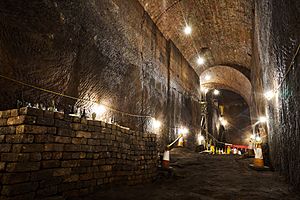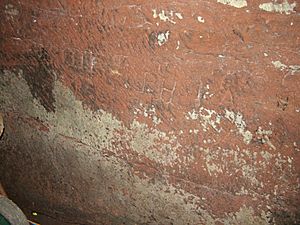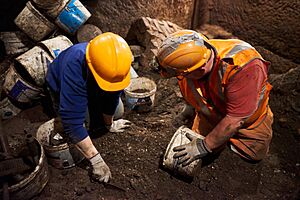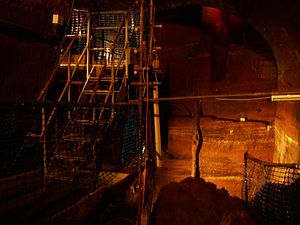Williamson Tunnels facts for kids
Quick facts for kids Williamson Tunnels |
|
|---|---|

The Banqueting Hall chamber beneath Joseph Williamson's house.
|
|
| Type | Excavations; possible sandstone quarries, or subterranean folly |
| Location | Edge Hill, Liverpool |
| Built | 1810–1840 |
| Restored | 1995–present |
| Restored by | Friends Of Williamson's Tunnels Joseph Williamson Society |
| Architect | Joseph Williamson |
| Lua error in Module:Location_map at line 420: attempt to index field 'wikibase' (a nil value). | |
The Williamson Tunnels are a fascinating network of underground spaces in the Edge Hill area of Liverpool, England. They were built between 1810 and 1840 by a rich man named Joseph Williamson. Even though they are called "tunnels," many of them are actually large rooms and passages dug out of the sandstone rock, with strong brick or stone arches built over them.
No one is completely sure why Williamson built these tunnels. Some people think he was digging for stone, others believe he wanted to give jobs to poor people, and some even think he was just an eccentric (a bit odd!) person with a strange hobby.
For many years, the tunnels were filled with rubble and rubbish, making them hard to reach. But since 1995, volunteers have been working hard to dig them out and explore them. Now, you can even visit parts of these amazing tunnels on guided tours! Two main groups, the Williamson Tunnels Heritage Centre and the Friends of Williamson's Tunnels, help people discover this hidden world. Volunteers are still finding new sections even today.
| Top - 0-9 A B C D E F G H I J K L M N O P Q R S T U V W X Y Z |
The Tunnels' Story: How They Began
Joseph Williamson: The Man Behind the Mystery
In 1805, a very wealthy businessman named Joseph Williamson bought some land in Mason Street, Edge Hill, Liverpool. This area was mostly open land with sandstone rock, where some small quarries had already been dug. Williamson started building houses on this land.
A writer from the 1800s, James Stonehouse, said that Williamson's houses were very unusual and didn't seem to follow any normal plans. The land behind the houses sloped steeply. To create large gardens, Williamson built arched terraces to extend the garden space. He kept building and changing many buildings there, including a big house for himself and his wife.
Building the Tunnels: A Job for Many
Williamson hired many poor and needy people from the area to do this work. This included soldiers who had lost their jobs after the Napoleonic War. Stonehouse mentioned that Williamson sometimes gave them strange tasks, like moving piles of rubble from one spot to another, and then moving it back again!
During the same time, Williamson's workers also dug out a series of brick-arched tunnels and vaults deep within the sandstone. These tunnels covered a large area, possibly even going beyond Williamson's own land. In 1845, James Stonehouse explored some of the tunnels. He described them as a maze of "vaulted passages" and "deep pits." He even mentioned a "frightening opening" under Grinfield Street with two "complete four-roomed houses" built into its side, connected by a spiral passage.
This tunnel-building continued until Williamson passed away in 1840. Later, in 1867, a local newspaper called the Liverpool Porcupine said the tunnels were a "great nuisance." This was because drains ran into them, creating pools of dirty water, and people were using them to dump rubbish.
The Tunnels Get Buried
In the late 1800s, the city of Liverpool started filling the tunnels with rubble and waste from demolished buildings. This continued into the 1900s. Not much information had been written down about the tunnels, so most of what people knew came from James Stonehouse's account from 1845. His work helped bring back some interest in Williamson and his mysterious tunnels.
Discovering the Tunnels Again
Early Explorations and Surveys
In 1881, a group of mining engineers visited Liverpool and surveyed some of the tunnels that were still open. They even drew a map of the main parts of the site.
In the early 1900s, soldiers from the 1st Lancashire Engineers also surveyed the tunnels. Their drill hall was built right on top of one of the tunnels! They made a map, but it wasn't complete because many parts were already filled with rubble.
Public interest in the tunnels faded for much of the 1900s. Many sites were buried or destroyed by new buildings. However, starting in the 1980s, people became more interested in Williamson again. This led to the creation of two main groups dedicated to exploring and digging out the tunnels.
In 1995, a student from Liverpool University used special equipment to survey the site. Later that year, a professional company also did a survey for the Joseph Williamson Society.
Digging Up the Past
Both the Joseph Williamson Society and the Friends of Williamson's Tunnels eventually got permission to start digging. Over time, they have uncovered a large part of Williamson's underground world, clearing away centuries of rubbish and rubble.
During the excavations, many interesting objects have been found. Some date back to the 1830s! These include old bottles, plates, pipes, vintage signs, and even military items. Most of these were probably just rubbish that people dumped in the tunnels. Many of these finds have been cleaned and are now on display for visitors to see.
How Big Are the Tunnels?
<mapframe latitude="53.405567" longitude="-2.956653" zoom="13" width="313" height="191" align="right"> { "type": "FeatureCollection", "features": [ { "type": "Feature", "properties": { "name": "Friends Of Williamson's Tunnels - Mason St" }, "geometry": { "type": "Point", "coordinates": [ -2.9581868648529057, 53.40498770289791 ] } }, { "type": "Feature", "properties": { "name": "Williamson Tunnels Heritage Centre" }, "geometry": { "type": "Point", "coordinates": [ -2.9587447643280034, 53.40397711513594 ] } }, { "type": "Feature", "properties": { "name": "Friends Of Williamson's Tunnels - Paddington" }, "geometry": { "type": "Point", "coordinates": [ -2.9573124647140503, 53.40619174210474 ] } } ] } </mapframe> The known tunnels are located in an area east of the Roman Catholic Liverpool Metropolitan Cathedral. This area is bordered by Mason Street, Grinfield Street, Smithdown Lane, and Paddington. We still don't know the full size of the tunnels, and many parts are still blocked by rubble.
The tunnels come in all shapes and sizes. Some are huge chambers, while others are too small for an average person to fit into. The "Banqueting Hall" is about 60 feet (18 meters) long and up to 27 feet (8 meters) high. The largest chamber at the "Paddington" site is shorter but an impressive 40 feet (12 meters) deep. Even bigger excavations, like the "Great Tunnel" described by early explorers, have yet to be found again.
Why Were the Tunnels Built?
The reason for these massive excavations has been a big mystery and a topic of much discussion. Williamson was very secretive about his reasons, which led to many local stories and legends.
Helping the Poor?
The most common explanation is that Williamson built them to help people. He supposedly said his goal was "the employment of the poor." His workers "all received a weekly wage and were thus enabled to enjoy the blessing of charity without the attendant curse of stifled self respect." This means he gave them jobs so they could earn money and feel good about themselves, rather than just receiving handouts.
Some parts of the tunnels seem to support this idea. There are many fancy architectural details that seem unnecessary, especially since they are deep underground and would have been dimly lit and rarely seen. For example, at the Mason Street site, a beautifully built stone arch was recently found in a plain side chamber, deep underground, with no clear reason for it to be there. These features could mean Williamson was helping his workers improve their building skills.
A Quarry or Something Else?
Another idea, which came from a TV show, suggested that Williamson was part of a religious group that believed the end of the world was coming. This theory suggests the tunnels were built as a refuge for him and his friends. However, there is no evidence to support this idea, and Williamson was a regular member of the Church of England.
Some early explorers thought the tunnels were just a strange hobby of an eccentric man. But others believed Williamson's goal of helping the poor was a good one. Many of Williamson's workers reportedly later found jobs building railways, using the skills they learned in the tunnels.
More recent research suggests that the "tunnels" were actually the result of Williamson's work to level the ground after quarrying. Most of the excavations are in high-quality sandstone and show signs of being dug using methods to get large pieces of stone for building. The old surveys also show a typical stone quarry shape. The seemingly random nature of the digging might have been because workers were following the best "seam" of stone, avoiding bad spots. So, the tunnels might have started as unregulated quarries for sandstone, used for important buildings in Liverpool. Williamson then built arches over them to level the ground, which helped him build his many houses on the site.
It was rumored that Williamson was making a lot of money from quarrying without permission. He claimed he made little money and used the stone for his own properties. It's possible his secrecy was to hide that he was avoiding income tax and fees for mineral rights. Williamson retired from his tobacco business in 1818, but he left a large fortune when he died. It seems a big part of this money must have come from his excavations and property development.
The Joseph Williamson Society and Heritage Centre

The Joseph Williamson Society was started in 1989. After a lot of digging and renovation, one part of the site, called the Stable Yard section, opened to the public in autumn 2002. It is now known as the Williamson Tunnels Heritage Centre (53°24′14″N 2°57′31″W / 53.403991°N 2.958721°W).
Visitors can take a guided tour to see a large part of the tunnels, including the impressive "Double Tunnel." Many artifacts found during the excavations are also on display. The Heritage Centre also hosts events and entertainment. The entrance to the center was once part of the Lord Mayor's Stable Yard, which closed in 1993.
Visiting the Heritage Centre
The Heritage Centre lets visitors explore a significant part of the tunnels. It is open Tuesday to Sunday during summer and Thursday to Sunday in winter. You don't need to book in advance. The center is also used for live music, events, filming, and training.
The Friends of Williamson's Tunnels (FoWT)
The Friends of Williamson's Tunnels (FoWT) is a charity run by volunteers. They are dedicated to exploring, digging out, and protecting the tunnels.
FoWT's main base is on Mason Street, where Joseph Williamson's house once stood. Most of the house is gone, but a small part of the front wall remains. However, excavations here have uncovered a huge underground area, with many tunnels branching off at different depths. Beneath the basement is a large room called the "Banqueting Hall." It got this name from old stories that Williamson held fancy parties there, but it's very unlikely it was ever used for that. As of 2019, the "Banqueting Hall" has been completely cleared, and volunteers are still digging in new tunnels leading from it.
Another section of tunnels is accessed from the "Paddington" site. This area has several levels of underground passages leading to a large vaulted chamber. This chamber is about 40 feet (12 meters) high from floor to ceiling. The floor of this chamber is about 60 feet (18 meters) below ground level and was cleared in 2016 after several years of digging.
These sites have been used for filming and have appeared in several documentaries about the tunnels and the FoWT volunteers. The group has also been featured in news reports on TV channels like the BBC and ITV.
Visiting FoWT Sites
The public can visit the "Paddington" site with free guided tours on Wednesdays and Sundays. The Mason Street site is open to FoWT members. Members can also attend regular historical talks and other events.
The Tunnels in Stories
- In Series 13 of Doctor Who, called Doctor Who: Flux, the Williamson Tunnels, along with Joseph Williamson and James Stonehouse, are part of the story. In the show, set in the 1820s, Williamson seems to know about a huge disaster coming in 2021 called the Flux, which destroys everything. Williamson appears in different places and times, suggesting the tunnels somehow contain portals across time and space. He explores these portals to find a way to stop the Flux. The Thirteenth Doctor and her friends use these portals to travel and hide from an alien invasion. After the Flux and the aliens are defeated, one of the portals is used to send a bad leader to a small asteroid.
- Joseph Williamson's life and the building of the tunnels have been made into a play and radio show by Karen Brown, a writer from Liverpool. The play is called The King of Edge Hill. It looks at how helping people can sometimes turn into an obsession. The radio version was broadcast in 2000 and was very popular. The stage version was performed in Liverpool in 2007 and won awards.





